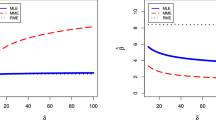Abstract
This paper presents a new simple, efficient and useful technique for constructing lower and upper unbiased prediction limits on outcomes in future samples under parametric uncertainty of underlying models. For instance, consider a situation where such limits are required. A customer has placed an order for a product which has an underlying time-to-failure distribution. The terms of his purchase call for k monthly shipments. From each shipment the customer will select a random sample of q units and accept the shipment only if the smallest time to failure for this sample exceeds a specified lower limit. The manufacturer wishes to use the results of an experimental sample of n units to calculate this limit so that the probability is γ that all k shipments will be accepted. It is assumed that the n experimental units and the kq future units are random samples from the same population. In this paper, attention is restricted to invariant families of distributions. The pivotal quantity averaging approach used here emphasizes pivotal quantities relevant for obtaining ancillary statistics and is applicable whenever the statistical problem is invariant under a group of transformations that acts transitively on the parameter space. It does not require the construction of any tables and is applicable whether the past data are complete or Type II censored. The proposed pivotal quantity averaging approach is conceptually simple and easy to use. For illustration, a left-truncated Weibull, two-parameter exponential, and Pareto distribution are considered. A practical numerical example is given.
Similar content being viewed by others
References
Hahn, G.I., Simultaneous prediction intervals to contain the standard deviations or ranges of future samples from a normal distribution, J. Am. Stat. Assoc., 1972, vol. 67, pp. 938–942.
Hahn, G.I., A prediction interval on the means of future samples from an exponential distribution, Technometrics, 1975, vol. 17, pp. 341–345.
Hahn, G.J. and Nelson, W., A survey of prediction intervals and their applications, J. Quality Technol., 1973, vol. 5, pp. 178–188.
Mann, N.R., Schafer, R.E., and Singpurwalla, J.D., Methods for Statistical Analysis of Reliability and Life Data, New York: John Wiley, 1974.
Fertig, K.W. and Mann, N.R., One-sided prediction intervals for at least p out of m future observations from a normal population, Technometrics, 1977, vol. 19, pp. 167–177.
Patel, J.K., Prediction intervals–a review, Commun. Stat.: Theory Methods, 1989, vol. 13, pp. 2393–2465.
Mann, N.R. and Saunders, S.C., On evaluation of warranty assurance when life has a Weibull distribution, Biometrika, 1969, vol. 56, pp. 615–625.
Mann, N.R., Warranty periods based on three ordered sample observations from a Weibull population, IEEE Trans. Reliab., 1970, vol. 19, pp. 167–171.
Antle, C.E. and Rademaker, F., An upper confidence limit on the maximum of m future observations from a Type 1 extreme value distribution, Biometrika, 1972, vol. 59, pp. 475–477.
Lawless, J.F., Prediction intervals for the two parameter exponential distribution, Technometrics, 1977, vol. 19, pp. 469–472.
Engelhardt, M. and Bain, L.J., Prediction limits and two-sample problems with complete or censored Weibull data, Technometrics, 1979, vol. 21, pp. 233–237.
Engelhardt, M. and Bain, L.J., On prediction limits for samples from a Weibull or extreme-value distribution, Technometrics, 1982, vol. 24, pp. 147–150.
Fertig, K.W., Meyer, M.E., and Mann, N.R., On constructing prediction intervals from a Weibull or extreme value distribution, Technometrics, 1980, vol. 22, pp. 567–573.
Nechval, N.A., Berzins, G., Purgailis, M., and Nechval, K.N., Improved estimation of state of stochastic systems via invariant embedding technique, WSEAS Trans. Math., 2008, vol. 7, pp. 141–159.
Nechval, N.A., Purgailis, M., Berzins, G., Cikste, K., Krasts, J., and Nechval, K.N., Invariant embedding technique and its applications for improvement or optimization of statistical decisions, in Analytical and Stochastic Modeling Techniques and Applications, Al-Begain, K., Fiems, D., and Knottenbelt, W., Eds., Heidelberg: Springer, 2010, pp. 306–320.
Nechval, N.A., Nechval, K.N., Purgailis, M., and Rozevskis, U., Improvement of inventory control under parametric uncertainty and constraints, in Adaptive and Natural Computing Algorithms, Part II, Dobnikar, A., Lotric, U., and Ster, B., Eds., Heidelberg: Springer, 2011, pp. 136–146.
Nechval, N.A., Berzins, G., and Danovics, V., Optimization of statistical decisions for age replacement problems via a new pivotal quantity averaging approach, Am. J. Theor. Appl. Stat., 2016, vol. 5, pp. 21–28.
Nechval, N.A., Nechval, K.N., and Strelchonok, V.F., A new approach to constructing tolerance limits on order statistics in future samples coming from a normal distribution, Advances in Image and Video Processing (AIVP), 2016, vol. 4, pp. 47–61.
Nechval, N.A., Nechval, K.N., and Purgailis, M., Statistical inferences for future outcomes with applications to maintenance and reliability, Lecture Notes in Engineering and Computer Science: Proceedings of the World Congress on Engineering, WCE 2011, July 6–8, 2011, London, 2011, pp. 865–871.
Nechval, N.A., Nechval, K.N., Prisyazhnyuk, S.P., and Strelchonok, V.F., Tolerance limits on order statistics in future samples coming from the Pareto distribution, Autom. Control Comput. Sci., 2016, vol. 50, pp. 423–431.
Nechval, N.A. and Nechval, K.N., Characterization theorems for selecting the type of underlying distribution, Proceedings of the 7th Vilnius Conference on Probability Theory and 22nd European Meeting of Statisticians, Vilnius: TEV, 1998, pp. 352–353.
Muller, P.H., Neumann, P., and Storm, R., Tables of Mathematical Statistics, Leipzig: VEB Fachbuchverlag, 1979.
Author information
Authors and Affiliations
Corresponding author
Additional information
The article is published in the original.
About this article
Cite this article
Nechval, N.A., Berzins, G., Balina, S. et al. Constructing unbiased prediction limits on future outcomes under parametric uncertainty of underlying models via pivotal quantity averaging approach. Aut. Control Comp. Sci. 51, 331–336 (2017). https://doi.org/10.3103/S0146411617050054
Received:
Accepted:
Published:
Issue Date:
DOI: https://doi.org/10.3103/S0146411617050054



